PAGE 3.
Once all of these ruins (haikyo) were bustling centers of life, industry, ambition, and dreams.
Now only the bones remain, toxic assets and distant memories in the minds of aging Japanese, but witness for us all to the silent struggle played out every day as time creeps on, nature takes back what was once its own, and we all move closer to the drowsy blush of forgetfulness and the endless sleep of death.
Yamamoto Grand Center | BE labs Resort Hotel |
 | 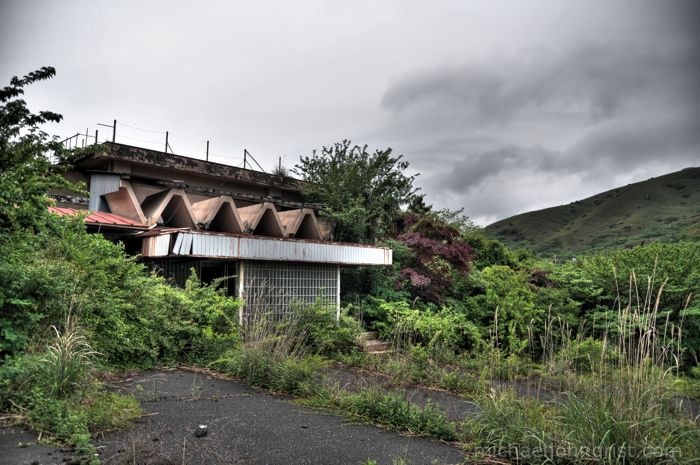 |
| The Yamamoto Grand Center is a gracefully aging architectural joy, tucked away in a quiet corner of Tochigi prefecture on a die-cut volcanic crag. Once its spacious halls hosted large functions and company retreats, children played in its courtyard and newlyweds posed for photographs by its sheer rock wall. Now it is empty. | The BE labs haikyo in Shizuoka is mis-representing itself somewhat by posing as a lab; at best it was a spa-resort for people who worked at a lab, somewhere far off and long ago. It sits in the crook of some distinctly un-Japanese rolling hills, looking rather like a bunker with its zig-zag concrete front-eave and fence-wires on the flat-slab roof. |
Yamanaka Lake 1. Resort Hotel | Yamanaka Lake 2. Spa Resort |
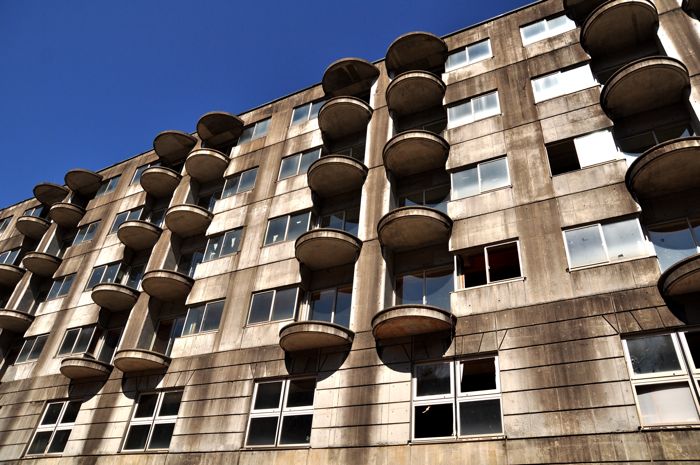 |  |
| The Yamanakako Resort Hotel at the foot of Mt. Fuji is another Bubble-era dead-end, a half-built extravagance that freezes in time the moment the crash occurred. Its rooms lie fallow and bare, uncarpeted and unpainted, with no furnishings but for dusty bath-tubs still in their vinyl casts. | The Yamanakako Spa Resort Hotel in Yamanashi prefecture was an unremarkable complex, a simple red brick structure set off from the road on a slight hill. The first building in the complex was guarded by the dead and dessicated corpse of a bristly wild pig. |
Yamanaka Lake 3. Secret Vault | Baba’s Old Curiosity Shop |
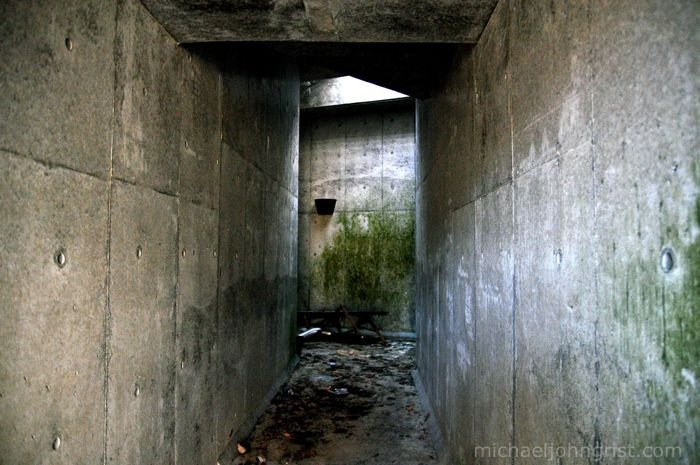 |  |
| The underground vault haikyo in Yamanashi is one of the strangest abandoned structures I’ve yet explored. A double-doored double-walled walk-in safe with triple combination locks buried in a man-made mound in an unpopulated and obscure part of the Japanese countryside, now with its thick and weighty doors hanging open and loose. | The old curiosity shop in Takadanobaba has been a mystery to me for a long time. I first spotted it passively years ago, before I lived near here, most likely on a trip to the Blue Parrot second-hand book store. |
Sun Hills Hotel Car Park | Shin Shu Kanko Hotel |
 |  |
| The remnants of the Sun Hills Hotel in Kanagawa lay hunkered down and spartan on the banks of Sagamiko lake, the blank concrete foundation of a proud edifice that never once opened to the public, hosting only the village’s truanting kids and vandals before it was unceremoniously torn down. Now only its 2-story underground car park remains, haunted by chirping crickets and wandering families on sight-seeing breaks. | The Shin Shu Kanko Hotel in Nagano is a leviathan beast, 3 whale-sized buildings interlinked by encircling roads, interior corridors, underground passages and a long bridging escalator. The largest of the 3 is seven stories high with easily 100 rooms along its spine, with huge onsen, function rooms, izakaya and a hall, all of it empty, trashed, and creaking in the wind. |
Tai-Hei-Yo Cement Plant | Cosplay Factory Haikyo |
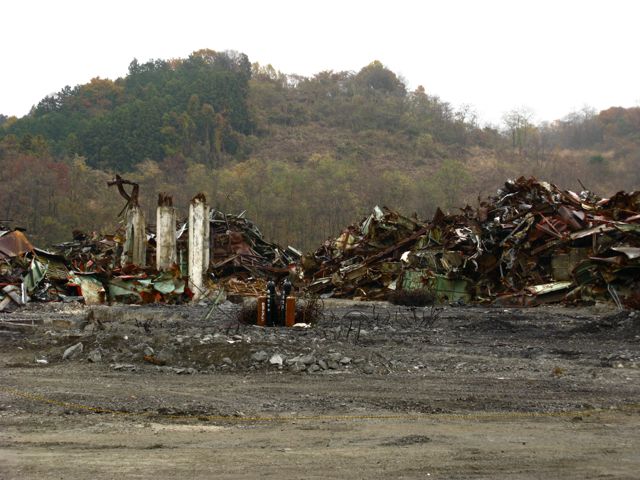 | 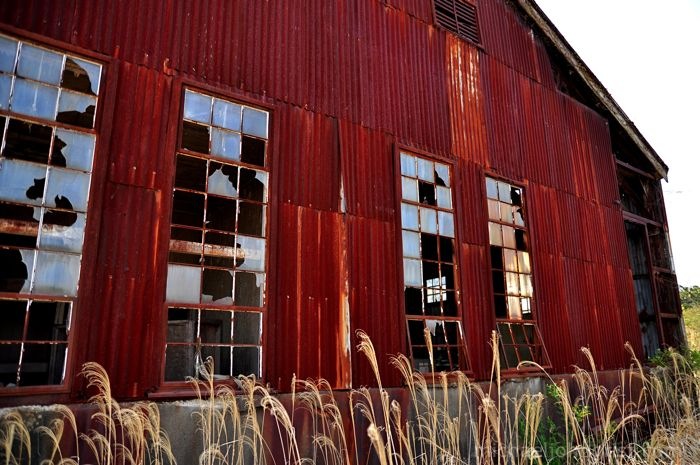 |
| The Tai-Hei-Yo Cement Plant Haikyo in Chichibu, Saitama, was once one of Japan’s biggest producers of concrete, a massive complex woven through with miles of piping, studded with huge firing kilns, silos, 30-story smoke-stacks and immense clinker vats. Now it’s a half-demolished scrapyard, strewn with piles of twisted metal wreckage, yellow chemical pools, bulldozers and cranes. | It’s rare to meet other people while exploring abandonments- by definition they should be empty, like dried-out rice husks blown in the wind. However from time to time it happens, and you may run up against an old man inexplicably stripping wood from fallen paper screens, or a gang of High School kids noisily playing truant. |
Shimoda Grand Hotel | Okutama Ropeway |
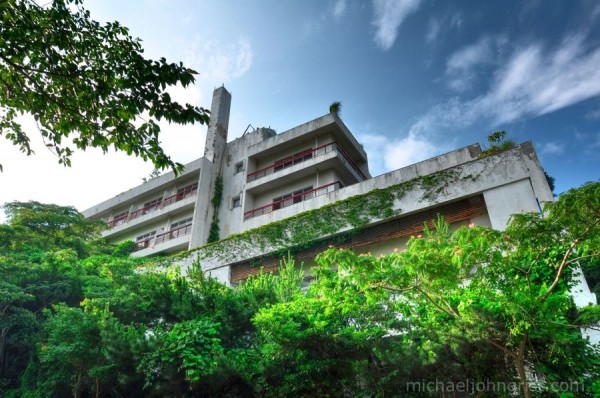 |  |
| The Shimoda Grand looms like a listing battleship on a swell of green, doomed to eventually sink without trace, swallowed up by the knotty growth of years. This was the third ruin on the first day of our road trip into Izu. Shimoda is famous for its gorgeous (imported) white sand beaches, and for being the lookout point where Colonel Perry was first seen chuffing towards Tokyo harbor in his black iron-clad steam ships. | Scrunched up behind thickets of winter-boned brush off the banks of a man-made lake, the last remaining carriage of the Okutama Ropeway hangs slack in its berthing perch. Once a completely false folly, it is now consigned to be the most natural thing there, with clotted brown leaves as its only passengers, vines clinging to the station walls the only attendants. |
Ashio Ghost Town 1. History | Ashio Ghost Town 2. Shrine |
 |  |
| Ashiodozan Mining Town in the mountains of Tochigi Prefecture is infamous in Japanese history as a site of extreme environmental damage- so much so the town was mostly abandoned 40 years ago, the mines and factory shut down, and virtually all of the people left. Now it’s just a creaking conglomeration of fading facilities. | Life in Ashio would never have been easy, and certainly not at the peak of production around 1910 when 39,000 people called it home. Many would have turned to the ‘kamisama’ or Gods for spiritual succor- especially as there were no cinemas, malls, or any other way to relieve the stresses of everyday life. |
Ashio Ghost Town 3. Power Hub | Ashio Ghost Town 4. Factory |
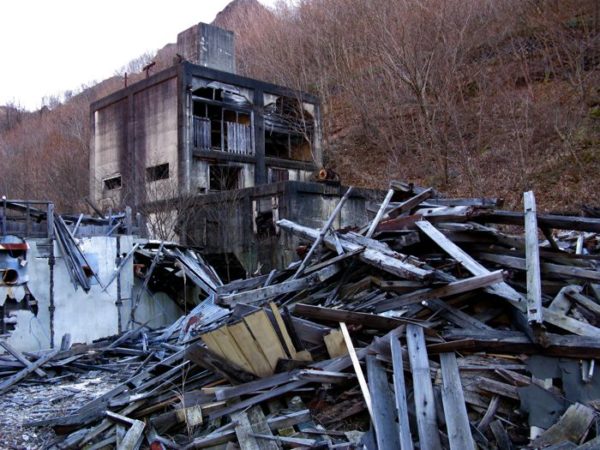 | 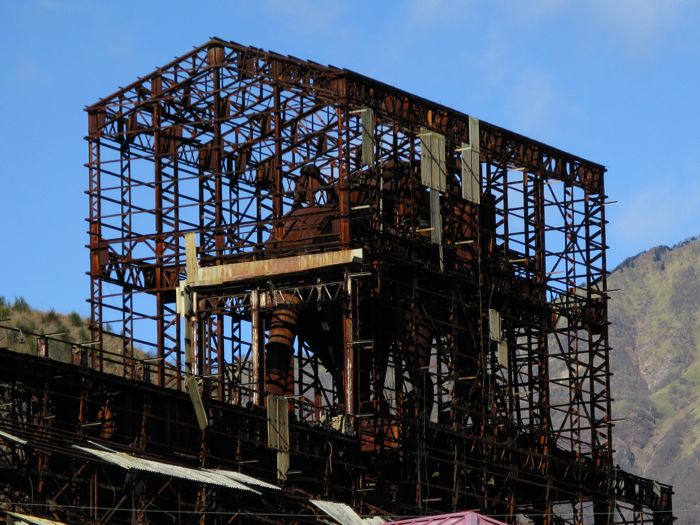 |
| Mining for Copper began in Ashio over 380 years ago, on the chance discovery of a surface lode by 2 farmers tilling their rocky topsoil. Shafts were dug and miners sent in, the process was commandeered by the Shogunate of Tokugawa Ieyasu, and production went into overdrive. | In Ashio Japan learned the true cost of industrialization, that of crippling environmental damage, as sulfuric acid from the factory numerous smelter chimneys coagulated in the atmosphere and fell as acid rain, poisoning the water table and blistering the mountains so all plant-life died. |
Dental School | Rojin Home |
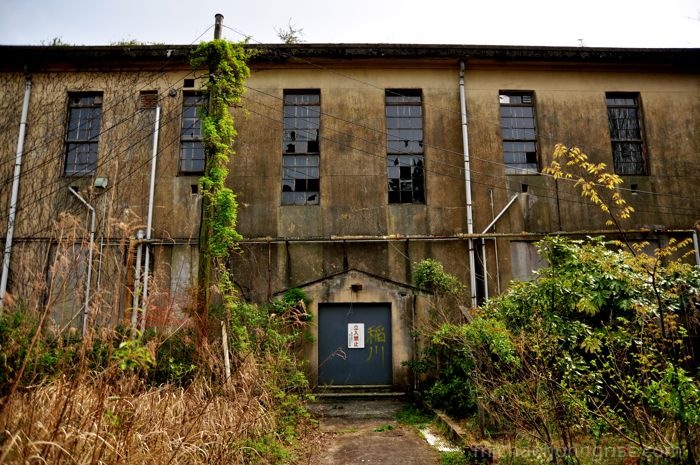 | 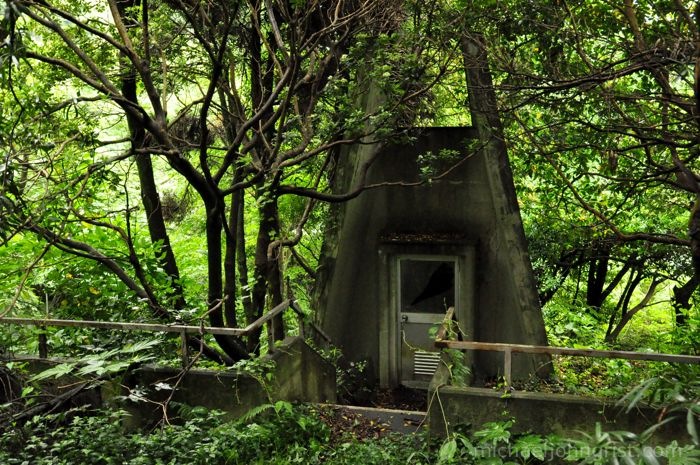 |
| The Dental School Haikyo in Ibaraki is one giant nest, a big empty shell carpeted with straw and twittering with the sound of swooping birds. Every room, corridor, and hall is scattered with their off-cast building materials, feathers, droppings, and bodies. Broken EXIT signs, fire-hose cupboards, sinks and shattered fuse-boxes all serve as their homes, stuffed with rotten straw and twigs. | The Rojin (old folks) Home we stumbled across in Shizuoka was a happy accident, one of those random call-outs from the back seat of the car that normally go unheeded. We were searching for an abandoned hospital and having little luck- so the mere sight of anything remotely fenced-off fired up our blood and got us out there investigating. |
Osawa Apartments | Toyoshin Convalescent Centre |
 | 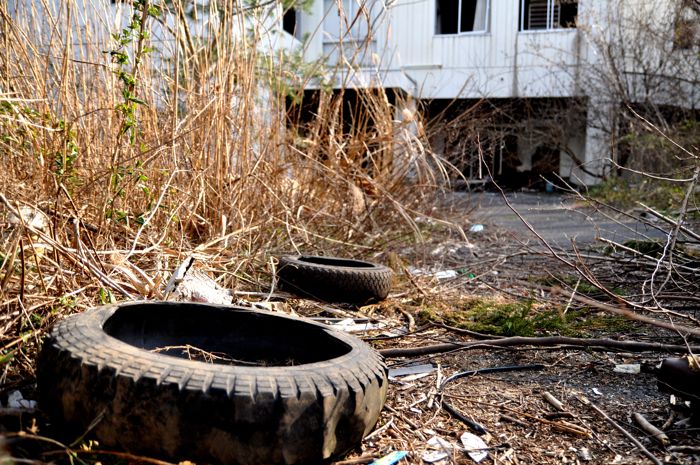 |
| The Osawa Apartments Haikyo in Sagamihara is a high-walled preserve for the recent past, shuttered in behind a plate-metal security fence 15 feet high. Inside, bicycles lie rusted in fallen racks, and 6-mat rooms rest empty behind locked screen doors, their tatami mat floors slowly bleaching white in the pale autumn sun. | The Toyoshin Convalescent Centre is an oddity already sunk from the consciousness of the neighbouring area, something the local kids don’t even notice as they walk past it to and from school. No fences or barricades of any kind guard its door or driveways, but no-one ventures inside. |
Nichitsu Ghost Town 1. Jn. School | Nichitsu Ghost Town 2. Ele. School |
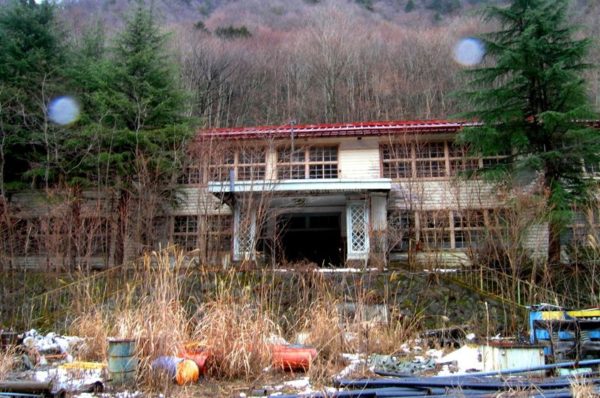 |  |
| The abandoned Nichitsu Mining Town sits cramped into a narrow valley at the head of a long and buckled road in the mountainous western edge of Saitama. It was once a thriving company town with hundreds of families, the women staying at home in their rickety apartments, the children at the large wooden high school, and the men down in the mines digging for tin. | At the dead-end of a blast-hewn road snaking up through the canyons of North-East Saitama, the Nichitsu mine ghost town lies in wait, wreathed in a low mist and perennially dusk-lit by the overhanging crags. It hums with a crippling weight of nostalgia, of enfolded memories playing out again and again in its boarded up buildings, of invisible ghosts walking their habitual paths to and from and back again. |
Nichitsu Ghost Town 3. Town | Nichitsu Ghost Town 4. Dr.’s Office |
 | 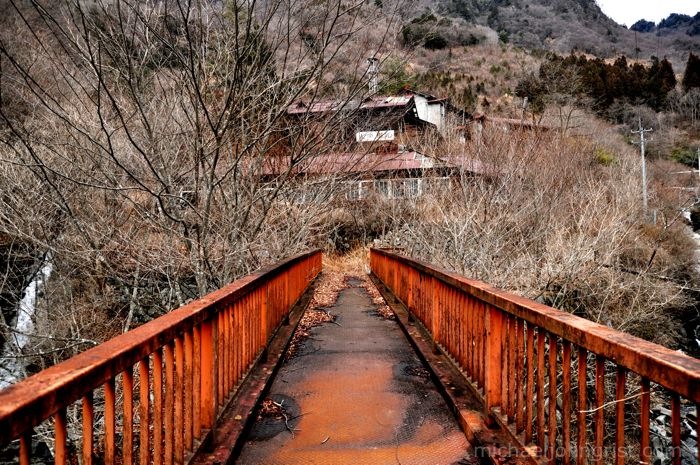 |
| Nichitsu Ghost Town stretches dead and decaying for over a kilometer along its switch-backed mountain road, spreading from the barely-functioning mine shacks at the mouth of the last rough-cut tunnel, up past the Junior High School, twisting up past the white bulge of a hill of lime-chips, past the Doctor`s office hidden somewhere in the thicket of buildings, up to the Lower School, dorm, and warren of walkways, all still and silent but for the steady low gnawing of nature, and time. | Nichitsu is a tiny little village huddled in a chilly mountain pass, far from the nearest population center. Come an emergency the Doctor’s office would have been the only ER, so its few rooms were crammed full of equipment, now forgotten and lying in shadow: rusted iron operating tables, toppled X-ray machinery, documents sheafed and scattered everywhere, surgical clamps in heaps and organs floating in formaldehyde jars. |
Go to the next page for love hotels, the grand and now demolished ruin of Sports World, plus various US-occupation era military ruins.
Page 1 | Page 2 | Page 3 | Page 4 | Page 5 |

Comments 12
What a sadly awesome page. “Ozymandius East”.
Great shots! I’d love to visit places like those, it looks amazing, yet quite frightening! How do you find them?
Author
David- Thanks, that’s a great title. Maybe I’ll borrow?
Val- Thanks so much, about half come from a book I have, and the other half from various tip-offs or random finds of my own. Only really frightening when I’ve gone solo, and at night. With friends it’s more just like fun.
Hello Michael,
I don’t know whether you’ll be having a look at this, but I simply wanted to thank you for this awesome website which have caught my interest for the past 2 days 🙂
Your haikyo pictures and articles are captivating and I started having a look at your writings as well.
I should be moving to Japan in January, and feel truly excited that I might be visiting such places. My interest in ruins started as a child. Fairly close to my house (in France) was an old psychiatric complex that, I realize know, was the ideal haikyo. The old building was fairly unstable but the newer one was amazing : big windows, furniture and medical equipment… This place was the absolute nightmare of my childhood and it took me 15 years to get inside, just before they demolished it!
Anyways, all this to say thank you for your amazing work 🙂
Cheers
Hello:
I think you used to have a link to my site, previously urbex.mikeonline.ca. I would like to have such an exchange again. Your site is currently listed on my site, which has changed to http://urbexobsession.com.
Thanks for your time.
Hi, could I use this picture: http://www.michaeljohngrist.com/wp-content/uploads/2009/08/sherman-tank-off-garapan-beach-saipan-90021.jpg for my article? Of course with a proper attribution and a link to your website.
Hi there, I really love your photos from the Nara Dreamland. I’m headed to Osaka at the end of the month, would you be kind enough to suggest “haikyos” (I learnt this word here!) that I could check out around the region? I’m looking forward to head to Nara Dreamland.
Hi MJG
One of my all-time favourite movies is Sen to Chihiro no Kamikakushi, so reading your blogpost about ruins in Japan has probably been the most exciting thing I will be doing this Christmas! 🙂 Hope you are still exploring and sharing – I see this post is nearly a decade old now.
Take care.
R
I was trying to find information about the old Yawata Steel Works and the old Space World Amusement Park in Kyushu, to see if I could sneak in and photograph, then I found your site. What really grabbed me was the piece on Camp Drake, my first assignment in the Air Force. So, anyway, thanks for the memories and keeping this site up.
Love lov e love this site
Sir I would like to use the following photo of yours on my site an one of the Tachikawa AB pages Tachikawa
Air Force Base re claimed by nature, Tachikawa Air Force Base Haikyo11 and Tachikawa Air Force Base Haikyo24.
Thank you
I was stationed at Fuchu AB 1966-1969 and my first daughter was born in Tachi Hospital.
We had a small car (as did everyone else) and went to Yakota Base for less expensive shopping than Fuchu, thanks to the Fuchu PX run by the base commanders’ wife…too rich for an Airman’s salary.
Tremendous memories from our time in Japan.